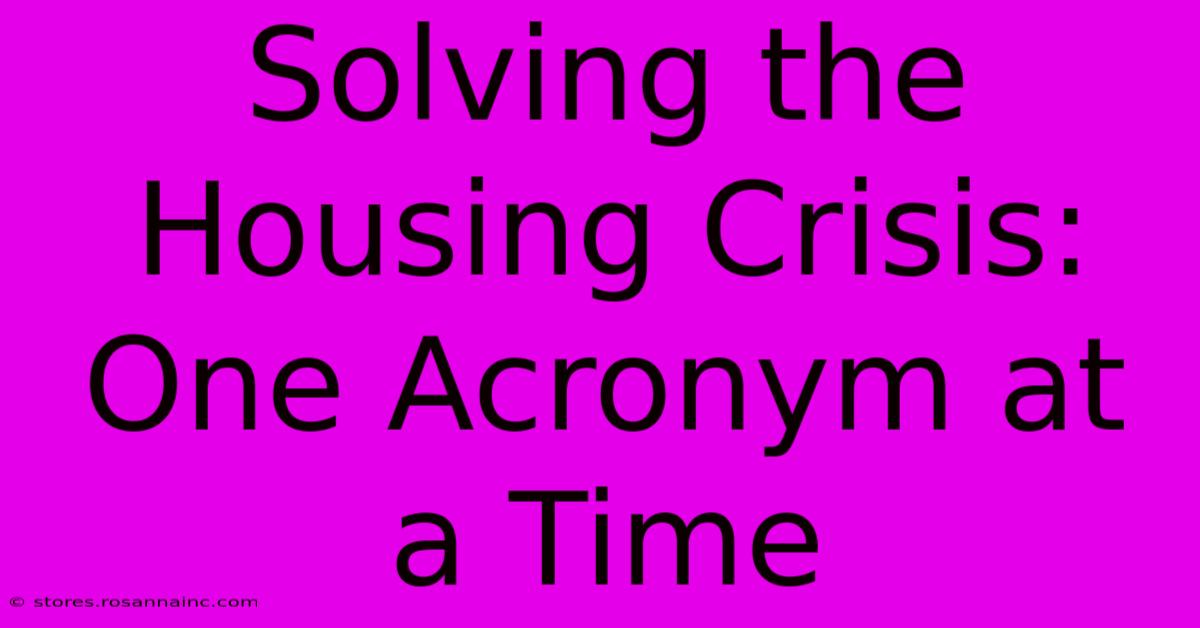Solving The Housing Crisis: One Acronym At A Time

Table of Contents
Solving the Housing Crisis: One Acronym at a Time
The housing crisis isn't a single problem; it's a complex web of interconnected issues. Understanding these issues requires deciphering a language of acronyms – YIMBY, NIMBY, LIHTC, and more. This article breaks down these key terms, exploring how they contribute to the crisis and what solutions they represent (or hinder). We'll delve into the multifaceted nature of the problem, examining both the challenges and potential pathways towards a more equitable and accessible housing market.
Understanding the Acronyms: Decoding the Housing Crisis
The housing crisis is often discussed in shorthand, using acronyms that can be confusing for those outside the field. Let's unpack some of the most important:
NIMBYism: Not In My Backyard
NIMBYism stands for "Not In My Backyard." This attitude reflects the resistance from residents to new housing developments, often citing concerns about increased traffic, noise, property values, and the character of their neighborhood. While understandable from an individual perspective, NIMBYism significantly restricts housing supply, contributing directly to rising prices and shortages. It's a major obstacle to creating more affordable housing options.
YIMBYism: Yes In My Backyard
In contrast to NIMBYism, YIMBYism ("Yes In My Backyard") advocates for the construction of more housing, even in established neighborhoods. YIMBY advocates argue that increased density and diverse housing options are crucial to addressing the affordability crisis. They emphasize the benefits of increased housing supply, including economic growth and greater social equity. The YIMBY movement actively challenges restrictive zoning laws and promotes inclusive community development.
LIHTC: Low-Income Housing Tax Credit
LIHTC stands for Low-Income Housing Tax Credit. This is a significant federal program that provides tax credits to developers who build or rehabilitate affordable rental housing for low-income families. LIHTC is a crucial tool for increasing the supply of affordable housing, but it often faces challenges related to funding limitations and bureaucratic hurdles. The program's success relies on effective allocation and strong community support.
Inclusionary Zoning: A Key Strategy
Inclusionary Zoning (IZ) ordinances require developers of new housing projects to include a certain percentage of affordable units. This strategy aims to integrate affordable housing within market-rate developments, promoting socioeconomic diversity and reducing neighborhood segregation. Effective IZ ordinances require careful planning and consideration of local market conditions to avoid unintended consequences.
Beyond the Acronyms: Addressing the Root Causes
While understanding the acronyms is crucial, it's essential to address the broader factors contributing to the housing crisis:
- Zoning Regulations: Restrictive zoning laws often limit density and the types of housing allowed, hindering the construction of diverse and affordable housing options. Reform of these regulations is a key part of many solutions.
- Land Use Policies: Policies that favor single-family homes over multi-family dwellings exacerbate the shortage of affordable housing. A shift towards more diverse land use policies is necessary.
- Funding Shortages: Insufficient funding for affordable housing initiatives limits the construction and preservation of affordable units. Increased investment is crucial to address this issue.
- Construction Costs: The high cost of construction materials and labor contributes to the overall cost of housing, making it difficult to create affordable options.
Moving Forward: Strategies for Change
Solving the housing crisis requires a multi-pronged approach:
- Promote YIMBY initiatives: Encourage community support for new housing developments, even in established neighborhoods.
- Reform zoning regulations: Update outdated zoning laws to allow for increased density and diverse housing types.
- Increase funding for affordable housing: Secure more funding for programs like LIHTC and other initiatives aimed at increasing the supply of affordable housing.
- Implement inclusionary zoning: Require developers to incorporate affordable units in new housing projects.
- Support community land trusts: These organizations acquire and maintain land for affordable housing, ensuring long-term affordability and community control.
By understanding the issues and actively promoting solutions, we can move beyond the acronyms and work towards a future where everyone has access to safe, stable, and affordable housing. The conversation needs to move beyond simply debating acronyms and focus on enacting meaningful change for all members of our communities.

Thank you for visiting our website wich cover about Solving The Housing Crisis: One Acronym At A Time. We hope the information provided has been useful to you. Feel free to contact us if you have any questions or need further assistance. See you next time and dont miss to bookmark.
Featured Posts
-
Hear Our Voices The Coreys Fight For Accountability
Feb 09, 2025
-
Ufc 312 Du Plessis Fight Predictions
Feb 09, 2025
-
Lakers Defeat Pacers Reaves Impact
Feb 09, 2025
-
Transform Your Style The April O Neil Inspiration
Feb 09, 2025
-
Binge Worthy Jonathan Brandis Where To Stream His Best Work
Feb 09, 2025
